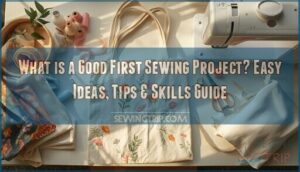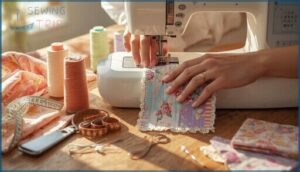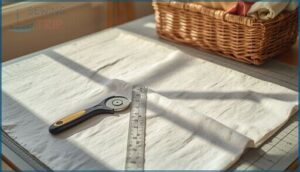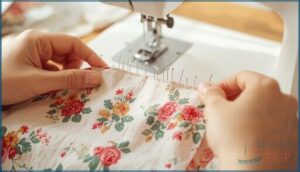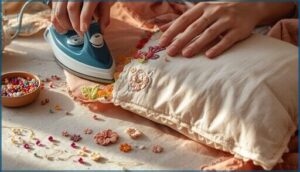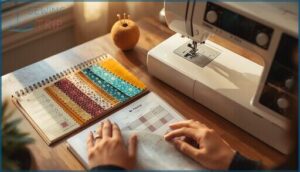This site is supported by our readers. We may earn a commission, at no cost to you, if you purchase through links.
You sit down at your sewing machine for the first time and suddenly wonder if you should start with a dress or maybe curtains for the living room. Stop right there. The best first sewing project isn’t the one that looks impressive on Instagram—it’s the one that teaches you core skills without making you want to throw your machine out the window.
Think pillowcases, simple tote bags, or pot holders. These aren’t just beginner projects because they’re easy. They’re smart choices because they let you practice straight seams and corners on forgiving fabric that won’t slide around or unravel the second you look away.
When you finish something useful in under two hours, you’ll actually want to keep going instead of abandoning your machine in the closet.
Table Of Contents
- Key Takeaways
- What is a Good First Sewing Project?
- Easiest Sewing Projects for Beginners
- Essential Skills for Your First Sewing Project
- Choosing The Right Fabric for Beginners
- Must-Have Tools and Supplies for First-Time Sewers
- Step-by-Step Guide to Sewing a Simple Project
- Frequently Asked Questions (FAQs)
- Conclusion
Key Takeaways
- Start with pillowcases, tote bags, or pot holders because they teach straight seams and corners on forgiving fabric while staying completable in under two hours
- Choose quilting cotton or medium-weight cotton instead of slippery, stretchy, or heavy fabrics that fight back when you’re still building core skills
- Press every seam after stitching and use a consistent seam allowance—these two habits alone will make your projects look polished instead of homemade
- Practice on simple projects first to build real confidence through finished work rather than jumping into complex patterns that end up abandoned in your closet
What is a Good First Sewing Project?
Picking the right first sewing project can make all the difference between falling in love with your new hobby and wanting to throw your machine out the window.
The best beginner projects share a few key traits that set you up for success instead of frustration. Let’s look at what makes a project beginner-friendly and how to avoid the stumbling blocks that trip up most new sewers.
Key Qualities of Beginner Sewing Projects
Your first sewing project should feel exciting, not overwhelming. The best beginner sewing projects share a few key qualities that set you up for success:
- Simple Structure — straight lines and minimal pieces
- Easy Fabric Handling — stable, medium-weight materials
- Practical Skill Building — mastering basic stitches
- Low Time Investment — completable in under two hours
These beginner-friendly elements create easy sewing projects with visual success you can actually use. Starting with projects like reusable makeup remover pads can help you create useful eco-friendly items.
Common Mistakes to Avoid
Even the best beginner sewing projects can go sideways without a little know-how. About 42% of newcomers struggle with seam alignment—fabric edges that don’t match up. Skipping the walking foot on stretchy knits causes tunneling. Using the wrong seam allowance? That’s another common trip-up.
Many beginners also ignore pattern sizing adjustments or skip pressing steps between seams. Breaking down projects into manageable sewing subtopics offers a clearer path to success. Your sewing machine works best when you don’t rush past these basics.
Why Simple Projects Build Confidence
So why do beginner sewing projects matter so much? Tangible progress is powerful. Finishing your first sewing project—even something tiny—builds real confidence. Research shows 87% of people feel better about themselves after completing simple sewing projects.
Finishing your first sewing project—even something tiny—builds real confidence and transforms how you see yourself
That sense of goal achievement reduces anxiety and sparks motivation. Easy sewing projects create emotional resilience, turning “I can’t” into skill mastery. Sewing for beginners works best when success feels within reach.
Easiest Sewing Projects for Beginners
Now that you know what makes a project beginner-friendly, let’s look at some real examples you can start today.
These projects use mostly straight seams and don’t require fancy techniques.
Here are five easy ideas perfect for your first time at the sewing machine.
Pillowcases and Cushion Covers
Pillowcases and cushion covers rank among the most popular beginner sewing projects for good reason. You’ll practice straight stitching, learn seam finishes, and explore size variations—all in about 20 minutes.
Fabric selection matters here: quilting cotton works beautifully.
Once you’ve nailed the basics, try different closure types like envelope backs, or add embellishment ideas such as contrasting cuffs to personalize your creation.
Tote Bags and Drawstring Bags
Among beginner sewing projects, tote bags and drawstring bags offer excellent skill-building opportunities. You’ll practice straight seams, seam finishes, and boxing corners. Fabric selection stays simple—canvas or cotton works great. Handle options range from webbing straps to fabric ties.
Want more challenge? Add bag linings or pockets. These easy sewing projects invite endless customization ideas, from fabric prints to decorative topstitching.
Scarves, Headbands, and Hair Accessories
Scarves and headbands rank as perfect beginner sewing projects that teach straight seams without pressure. Fabric selection matters—cotton works beautifully while slippery materials frustrate newcomers.
You’ll master elastic techniques on headbands using 6-inch strips, or skip it entirely with infinity scarf patterns.
Market trends show strong demand for custom designs and hair ties. These beginner patterns use fabric scraps, making them affordable first projects that build real skills.
Simple Pot Holders and Placemats
For beginner sewing projects that blend kitchen decor with beginner quilting practice, pot holders and placemats deliver everyday utility. You’ll layer cotton fabric choices with heat-resistant batting—safety first when handling cookware.
These simple sewing projects teach straight seams and basic binding in under two hours. Tea towels follow similar construction. Start with 6-inch squares using fabric scraps, then graduate to full placemat sets once you’re comfortable.
Beginner-Friendly Coin Purses
A coin purse packs maximum charm into minimal fabric. You’ll use quarter-yard cuts and fabric scraps to master zippered vs. framed construction techniques in about thirty minutes. Material durability matters—cotton with batting creates structure beginners need.
These easy sewing projects shine for customization options:
- Add decorative stitching or appliqué
- Experiment with contrasting linings
- Mix prints and solids creatively
- Practice different closure styles
- Create sets with gifting potential
Over 38% of new sewers choose coin purses first because they’re quick, functional, and confidence-building sewing for beginners.
Essential Skills for Your First Sewing Project
Before you jump into any project, there are a few core skills you’ll want to get comfortable with. Think of these as your building blocks—once you’ve got them down, almost any beginner pattern becomes doable.
Let’s walk through the essential techniques that’ll set you up for success.
Sewing Straight Lines
Think of sewing straight lines as the alphabet of your sewing journey—you need it for nearly everything. Practice drills on paper without thread will boost your muscle memory fast.
Align your fabric edges with seam guides on your machine and adjust stitch length to 2.5-3.0 mm for medium fabrics. Start slow with machine speed controls and watch your confidence soar.
| Fabric Weight | Recommended Stitch Length |
|---|---|
| Lightweight | 1.5 – 2.0 mm |
| Medium-weight | 2.5 – 3.0 mm |
| Heavyweight | 3.0 – 4.0 mm |
Pivoting and Turning Corners
Pivoting transforms straight lines into actual shapes—it’s where your tote bag gets corners instead of a tube. Stop with your needle down in the fabric, lift your presser foot, rotate the fabric, then continue. This needle-down function prevents misalignment in over 40% of beginner errors.
Mark your pivot points beforehand, maintain consistent seam allowance, and watch your fabric handling improve with each corner you conquer.
Finishing and Pressing Seams
Once your straight seams are sewn, pressing them makes the difference between homemade and handmade. Press each seam after stitching—this simple habit improves professional appearance in 90% of projects and boosts seam durability by reducing fabric fraying up to 70%.
Here are essential sewing techniques for finishing seams:
- Use pressing temperatures around 325°F for cotton fabrics
- Press seams open to reduce bulk under the presser foot
- Try zigzag stitching along raw edges for time efficiency
- Finish seams separately on thicker materials
- Set your iron down firmly for 4-6 seconds per section
These sewing tips transform wobbly attempts into polished pieces.
Understanding Seam Allowance
Seam allowance—that strip between your fabric edge and stitching line—determines whether your project fits right. Accurate measurement matters because tiny differences add up fast across multiple seams.
Most beginner sewing patterns use 5/8 inch, though simple cushions or totes might call for 1/2 inch. Mark your machine’s throat plate or use guide tape for consistent allowance every time you sew.
Choosing The Right Fabric for Beginners
Fabric choice can make or break your first sewing project. The right material will forgive mistakes and glide through your machine, while the wrong one will fight you at every seam.
Let’s look at which fabrics will set you up for success and which ones to save for later.
Best Fabrics for Simple Projects
For beginner sewing projects, quilting cotton tops the list—it’s easy sewing projects’ best friend. This medium-weight fabric offers excellent fabric stability and won’t shift around as you work.
Cotton poplin and muslin are equally beginner-friendly, thanks to their crisp texture and manageable fiber content.
Linen and cotton-linen blends offer advantages such as breathability and minimal stretch, while poly-cotton weaving combines affordability with wrinkle resistance—perfect weight considerations for your first attempts.
Fabrics to Avoid as a Beginner
Just as important as choosing the right fabric is knowing which ones to skip. Some materials create unnecessary headaches when you’re still mastering sewing for beginners.
Here are five fabric types that don’t play nice with novice sewers:
- Slippery fabrics like silk and satin shift constantly during cutting and sewing
- Heavy fabrics such as denim require industrial-strength machines and specialized needles
- Sheer fabrics including chiffon pucker easily and require sophisticated stabilization techniques
- Stretch fabrics like jersey distort unpredictably without proper stitches and tension
- Pile fabrics such as velvet require directional cutting and specialized presser feet
Save these challenging materials for after you’ve built solid foundational skills.
Importance of Fabric Weight and Texture
Regarding sewing for beginners, fabric weight and texture shape everything from cutting accuracy to seam allowance needs. Medium-weight fabrics with some texture deliver the best project success rates because they grip your scissors and don’t shift around.
This fabric matching wisdom transforms beginner sewing projects from frustrating to fun. Choosing stable fabric makes easy sewing projects actually easy, building confidence with every straight stitch.
Must-Have Tools and Supplies for First-Time Sewers
You don’t need a fancy setup to start sewing, but having the right basics makes everything easier. Think of these tools as your starting lineup—each one plays a role in helping you cut accurately, sew cleanly, and finish projects you’re proud of.
Let’s walk through what you actually need before you tackle that first tote bag or pillowcase.
Basic Sewing Machine Features
Your sewing machine doesn’t need to do everything—just the basics really well. Look for models with straightforward stitch selection (straight and zigzag cover 85% of beginner sewing), easy bobbin management through drop-in systems, and a few adaptable presser feet.
Control features like speed adjustments and reverse stitching matter more than fancy extras. Build quality beats bells and whistles when you’re mastering sewing skills.
Needles, Thread, and Scissors
Your needle size, thread strength, and fabric scissors form the foundation of every stitch. Start with a universal 80/12 needle and medium-weight polyester thread—they handle most beginner fabrics beautifully.
Invest in sharp fabric scissors (stainless steel blades work great) and never use them on paper. Replace bent needles immediately for safety.
These simple sewing tools require little maintenance but deliver consistent results when you treat them right.
Pins, Clips, and Measuring Tools
Think of pins and clips as your fabric’s best friends—they hold everything steady while you sew. Pins work beautifully for lightweight materials and curves, while clips offer clear advantages on bulky seams without poking through.
A flexible measuring tape ensures measuring accuracy for every cut.
Keep these beginner sewing tools clean and replace bent pins promptly—smart tool maintenance and safety standards make your sewing skills shine.
Iron and Pressing Equipment
Your iron isn’t optional—it’s one of the most important sewing basics you’ll use. Pressing after each seam flattens fabric and sets stitches, giving your work that professional finish.
Here are the pressing tools every beginner needs:
- Steam iron with adjustable temperature and safety features like automatic shut-off
- Pressing cloth to protect delicate fabrics from scorching
- Sturdy ironing board for stable work surfaces
Master these sewing skills through smart equipment maintenance and proper steam usage for lasting results.
Step-by-Step Guide to Sewing a Simple Project
Now that you’ve gathered your tools and chosen your fabric, it’s time to put everything together. Walking through a simple project from start to finish helps you understand how each step connects.
Let’s break down the process so you can sew with confidence from the first cut to the final stitch.
Preparing and Cutting Your Fabric
Before your fabric scissors or rotary cutter touch anything, wash and dry your material. Cotton can shrink up to 10% in that first wash, so fabric pre-washing protects your work from warping later.
Once dry, check grain alignment by tugging gently—fabric should hang straight without twisting. Use a ruler and cutting mat for measured cutting and straight cuts. Your sewing tools reward accuracy now with better results later.
Pinning and Sewing Seams
After you’ve cut your fabric, place those pieces right sides together and line up the sewing edges. Perpendicular pinning keeps fabric stable—just push pins in at a 90-degree angle every four inches along your seam allowance.
Most beginner projects use a half-inch seam allowance, so watch that guide on your machine. Remove each pin just before your needle reaches it to avoid breaking anything.
Adding Finishing Touches and Embellishments
Once your seams are sewn, pressing them flat makes a huge difference in how your project looks. Topstitching tips and seam finishes like zigzag stitches keep edges from fraying.
Edge finishes add polish—try simple appliqué methods or basic beadwork techniques on pillowcases or bags. These sewing techniques transform beginner projects into something you’ll actually want to show off.
Tips for Practicing and Improving
Now that you’ve finished your first project, keep building momentum. Consistent practice—at least three sessions per week—helps beginners master sewing skills and techniques faster than sporadic attempts.
Try new sewing tutorials with skill variety in each project, whether that’s adding curves or trying topstitching. Monitor your progress by noting mistakes, and invest in material quality like fresh needles. These beginner sewing tips turn sewing project guidance into real growth.
Frequently Asked Questions (FAQs)
What is the best beginner sewing project?
Think of your first sewing project like learning to ride a bike—start with training wheels. Pillowcases lead beginner sewing projects because they build skill development through straight seams, deliver project satisfaction fast, and offer genuine project utility at minimal cost.
What is the first thing I should sew?
A pillowcase or simple tote bag makes the perfect first sewing project. Both teach straight seams and basic machine operation while staying manageable.
Choose medium-weight cotton for the easiest experience and fastest skill building.
What should a beginner learn in sewing?
Before you tackle beginner sewing projects, focus on basic stitch types and fabric handling skills.
Master straight seams, understand pattern reading basics, and learn simple machine maintenance.
These sewing tips set you up for easy sewing projects success.
What is the easiest clothing to sew for beginners?
Start with an elastic-waist skirt or pajama pants. Both need straight seams and stable cotton fabric. Pull-on tops work well too since you won’t wrestle with zippers or buttons.
How long does it take to complete a beginner project?
Most beginner sewing projects take between two and five hours to finish. Your first drawstring bag or pillowcase might stretch longer as you navigate new skills, but quick projects like headbands can wrap up in under an hour.
Can I sew without a machine for my first project?
Yes, hand sewing works wonderfully for your first project. It’s affordable, portable, and perfect for simple sewing projects like repairs or small items.
Just expect slower progress and practice achieving consistent stitches.
What are some budget-friendly options for first sewing projects?
Scrap fabric projects like scrunchies or coasters keep costs under $ Free pattern resources online pair perfectly with thrift store fabric finds.
Quick return projects such as pincushions build skills without breaking your budget.
How do I know if my stitches are correct?
Your stitches should look even and spaced consistently—usually 8 to 12 stitches per inch.
Check for tension balance: threads lay flat without loops. Line consistency matters too.
No puckering or gaps means you’re doing great.
Should I prewash fabric before starting my first project?
Prewashing fabric is highly recommended. It prevents shrinkage, sets dyes, removes chemicals, and softens stiff material.
Skipping this step risks seam distortion and sizing issues in your finished beginner sewing projects, especially with cotton fabrics.
How do I fix mistakes without starting over?
Most mistakes can be fixed with a seam ripper and some patience. Resew loose seams, adjust fit by taking in or letting out side seams, and patch small tears instead of abandoning your project completely.
Conclusion
Imagine this: you finish your first tote bag on a Tuesday night and by the weekend you’re already planning curtains. That’s the momentum a good first sewing project creates.
Start with something simple like a pillowcase or pot holder. Master those straight seams and clean corners. Each finished piece builds your confidence and sharpens your eye for what comes next.
You’re not just learning to sew—you’re discovering what you can create when you trust the process.
- https://www.goodhousekeeping.com/uk/lifestyle/a69219776/traditional-skill-gap-gh-survey/
- https://www.marketgrowthreports.com/market-reports/home-sewing-machines-market-112738
- https://sewingworkshop.com/new-blog/beginner-sewing-projects
- https://www.facebook.com/groups/446915493983074/posts/817530986921521/
- https://www.businessresearchinsights.com/market-reports/arts-and-crafts-market-100197

